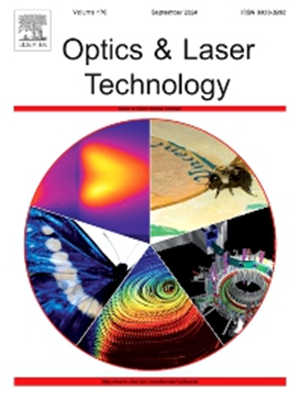用于拉曼探测的双波长复合光栅半导体激光器
IF 4.6
2区 物理与天体物理
Q1 OPTICS
引用次数: 0
摘要
双波长激光器可用于双波长干涉吸收测量、差频太赫兹产生和偏移激发拉曼差分光谱。因此,具有窄线宽和稳定波长的双波长激光器已成为研究的焦点。本文介绍了一种单片集成双波长复合光栅激光器的设计,该激光器集成了横向耦合光栅和不同周期的脊面光栅。为了减少模式竞争并提高稳定性,我们在激光器的两个布拉格系统之间设计了一个隔离槽结构,以实现两个纵向模式的选择。在 0.28A 的工作电流下,获得了两个波长间隔为 0.75 nm 的波长,中心波长分别为 782.47 nm 和 783.22 nm。当工作电流在 0.28A 至 0.35A 之间时,激光器实现了稳定的双波长振荡,最大双波长输出功率为 71.95 mW。因此,本研究开发的双波长器件可应用于移位激发拉曼差分光谱。本文章由计算机程序翻译,如有差异,请以英文原文为准。
Dual-wavelength composite grating semiconductor laser for Raman detection
Dual-wavelength lasers are utilized in dual-wavelength interferometric absorption measurement, difference frequency terahertz generation, and shifted excitation Raman difference spectroscopy. Consequently, dual-wavelength lasers with narrow linewidths and stable wavelengths have become a focal point of research. This paper presents the design of a monolithically integrated dual-wavelength composite grating laser, which integrates laterally coupled gratings and ridge surface gratings with different periods. To reduce mode competition and enhance stability, we designed an isolation groove structure between the two Bragg systems of the laser to achieve selection of two longitudinal modes. At an operating current of 0.28A, two wavelengths with a separation of 0.75 nm were obtained, with central wavelengths of 782.47 nm and 783.22 nm, respectively. When the operating current was in the range of 0.28A to 0.35A, the laser achieved stable dual-wavelength oscillation, with a maximum dual-wavelength output power of 71.95 mW. Thus, the dual-wavelength devices developed in this work can be applied to shifted excitation Raman difference spectroscopy.
求助全文
通过发布文献求助,成功后即可免费获取论文全文。
去求助
来源期刊
CiteScore
8.50
自引率
10.00%
发文量
1060
审稿时长
3.4 months
期刊介绍:
Optics & Laser Technology aims to provide a vehicle for the publication of a broad range of high quality research and review papers in those fields of scientific and engineering research appertaining to the development and application of the technology of optics and lasers. Papers describing original work in these areas are submitted to rigorous refereeing prior to acceptance for publication.
The scope of Optics & Laser Technology encompasses, but is not restricted to, the following areas:
•development in all types of lasers
•developments in optoelectronic devices and photonics
•developments in new photonics and optical concepts
•developments in conventional optics, optical instruments and components
•techniques of optical metrology, including interferometry and optical fibre sensors
•LIDAR and other non-contact optical measurement techniques, including optical methods in heat and fluid flow
•applications of lasers to materials processing, optical NDT display (including holography) and optical communication
•research and development in the field of laser safety including studies of hazards resulting from the applications of lasers (laser safety, hazards of laser fume)
•developments in optical computing and optical information processing
•developments in new optical materials
•developments in new optical characterization methods and techniques
•developments in quantum optics
•developments in light assisted micro and nanofabrication methods and techniques
•developments in nanophotonics and biophotonics
•developments in imaging processing and systems

 求助内容:
求助内容: 应助结果提醒方式:
应助结果提醒方式:


